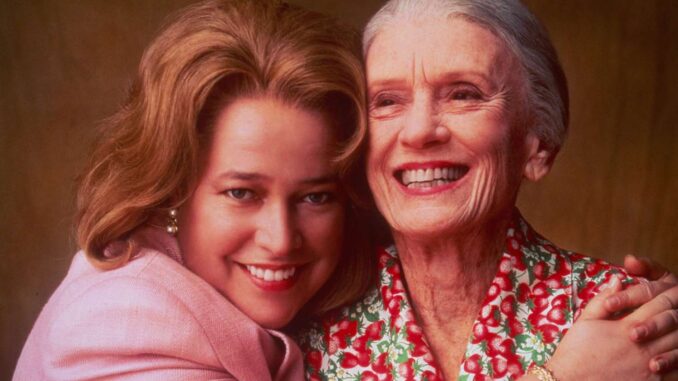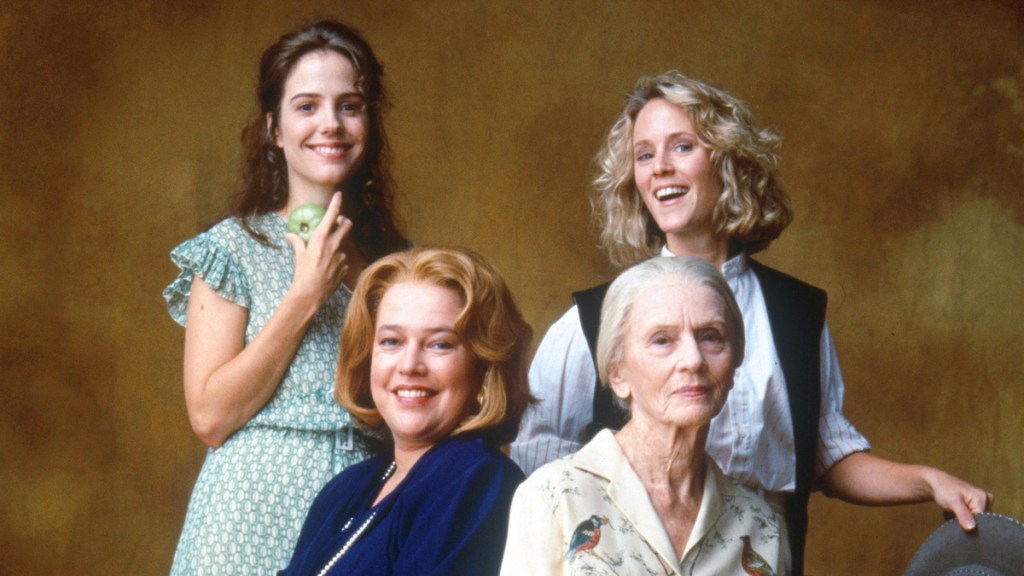
One of the greatest friendships in Southern fictional history is that of Idgie and Ruth, the two women at the heart of the classic film Fried Green Tomatoes. Based on Fannie Flagg’s classic novel, the movie tells the intertwined stories of two friendships. Ninny Threadgoode (Jessica Tandy) keeps Evelyn Couch (Kathy Bates) entertained with stories of her colorful past. Ninny’s most engaging tales involved the exploits of her free-spirited sister-in-law Idgie (Mary Stuart Masterson), who owned a small Alabama café in the 1920s, along with her best friend Ruth (Mary-Louise Parker).
Now, Idgie would do absolutely anything to help her dearest friend Ruth, so when Ruth winds up married to a monster of a man, Idgie steps in. The two end up raising Ruth’s child together while running a small café in Whistle Stop, Alabama.
The movie has everything—love, friendship, mystery, laughs, and a lot of good food with good friends—as well as impeccable writing and a stellar, Oscar-winning cast. Since its release in 1991, Fried Green Tomatoes has become a staple of Southern cinema.
Yet no matter how many times you’ve watched it, there is always more to the story. Here are 11 things that even die-hard fans of the Fried Green Tomatoes movie may not know.

The U.S. And U.K. Versions Had Different Titles
Flagg’s 1987 novel is titled Fried Green Tomatoes at the Whistle Stop Cafe, which is what the film was called in the U.K. and some other countries. That was apparently too much of a mouthful for U.S. audiences, though, where the film’s title was abbreviated to just Fried Green Tomatoes.
It Was Originally Written As A Musical
When he first started the process of bringing Fried Green Tomatoes to the screen, executive producer and director Jon Avnet hired Carol Sobieski. She came up with the idea of doing the story as a musical. Sadly, Avnet was not on board with the idea of Idgie and Ruth singing their way through the story.
It Was A Surprise Box Office Smash
The film was made for $11 million, which makes it low-budget in Hollywood terms. While it wasn’t an overnight smash hit, the film eventually grossed a whopping $81,000,000, proving that Southern stories can be loved by all.
The Whistle Stop Was Based On A Real Café In Alabama
Fannie Flagg’s great-aunt Bess Fortenberry started running the Irondale Café during the 1930s in the small town of Irondale, which is just outside of Birmingham, Alabama.
There’s A Real Whistle Stop Café
While Flagg’s real-life inspiration came from Alabama, Hollywood chose the small town of Juliette, Georgia, to stand in for Whistle Stop, and the set was turned into a tourist district. Now, visitors can drive about 20 minutes from Macon, sit at the Whistle Stop Café, and enjoy a plate of fried green tomatoes all day long, just like Idgie and Ruth.
There’s Even A Cookbook
After the movie came out, so many people asked for recipes that Flagg ended up writing a cookbook to accompany the film. The Original Whistle Stop Café Cookbook was published in 1993.
The Stunt Double Quit Right Before The Bee Scene
Remember when Idgie is momentarily covered in bees? Well, the stunt woman who was hired for the film was too afraid to actually do the stunt, and she backed out at the last minute.1 That left actress Mary Stuart Masterson with a tough choice—hold up the film or do the stunt herself. She jumped into the job, working with the buzzing bees, and making for a memorable cinematic moment.
Fannie Flagg Appeared In The Film
Flagg has a cameo in the movie, playing the leader of a self-help group, who tells the women in attendance: “You can get that spark back into your marriage!” This was not Flagg’s first time on camera. She appeared on Match Game throughout the ’70s and early ’80s and had a role in Grease and Five Easy Pieces.
Harper Lee Was A Big Fan
The reclusive To Kill A Mockingbird author reviewed the book, giving it a rave and saying, “Idgie Threadgoode is a true original: Huckleberry Finn would have tried to marry her!”2
Fried Green Tomatoes Weren’t Very Popular In The South Before The Film
This may sound like sacrilege to some, but according to Robert Moss, food writer and expert in food history, fried green tomatoes weren’t really a Southern dish until the movie made them one. While gardeners across the U.S. would fry up unripe tomatoes instead of letting them wither on the vine, the dish itself was not all that common in the South at the end of the 20th century. Then came the movie and along with it a huge, revived interest in the dish. Soon fried green tomatoes started appearing on menus across the South. “Fried green tomatoes weren’t always a marker of Southern cooking,” Moss writes, “but they sure are now.”3
The Movie Received Oscar Nominations
The movie was shot in 10 to 12 weeks, and it scored several Oscar nominations but did not win. Jessica Tandy was nominated for best supporting actress, and Fannie Flagg and Carol Sobieski were u.
